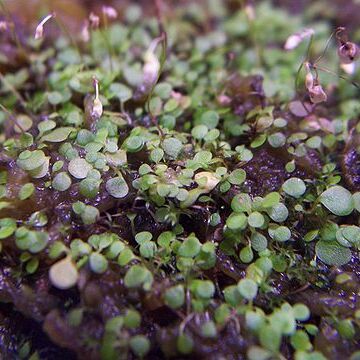Perennials, epiphytic or lithophytic. Rhizoids and stolons capillary, simple. Traps on rhizoids and stolons, stalked, ovoid, 0.6-0.8 mm, mouth lateral; appendage 1, dorsal, deeply 2-cleft, fringed with multicellular stipitate glands. Leaves numerous, from peduncle base and stolons, subsessile to petiolate; leaf blade obovate, orbicular, or transversely elliptic, 3-10 × 2-6 mm, thinly fleshy, veins dichotomously branched, base cuneate, attenuate, or rounded, margin entire, apex rounded. Inflorescences erect, 1-15 cm, 1-10-flowered; peduncle terete, 0.2-0.4 mm thick, glabrous; scales few, similar to bracts; bracts basisolute, narrowly ovate to oblong, 1-1.5 mm, glandular, base truncate, margin irregularly crenulate to denticulate, apex subacute to rounded. Pedicel spreading at anthesis but often pendulous and withered in fruit, 2-6 mm, capillary, slightly dorsiventrally compressed; bracteoles similar to bract but slightly smaller. Calyx lower lobe oblong-elliptic, much smaller than upper lobe, apex rounded to emarginate; upper lobe suborbicular to broadly obcordate, 1.5-2.5 mm, apex rounded to emarginate. Corolla white or violet, with a yellow spot at base of lower lip, 3-10 mm or much smaller when cleistogamous; lower lip transversely elliptic to suborbicular, apex 5-lobed; spur subulate, ± as long as lower lip, straight or curved, apex acute; palate fringed with hairs; upper lip subovate, much shorter than calyx, apex shortly 2-cleft. Filaments ca. 0.6 mm, straight; anther thecae distinct. Ovary ovoid to depressed globose; style very short; stigma lower lip semicircular, upper lip obsolete. Capsule globose, ca. 2.5 mm in diam., dorsiventrally compressed, dehiscing by a single longitudinal ventral slit. Seeds obovoid, 0.2-0.4 mm, densely covered with glochidiate processes except proximal end. Fl. Jun-Oct, fr. Jul-Nov.
Epiphytic herb.. Rhizoids and stolons capillary, numerous from base of the scape.. Leaves numerous and conspicuous at anthesis, rosulate at the scape-base and scattered on the stolons, obovate to reniform, petiolate, 3–10 mm. total length, the lamina 1–6 mm. wide.. Traps numerous, globose or ovoid, 0.6–0.8 mm. long, stalked; mouth lateral; upper lip shortly projecting with 2 divergent appendages densely covered with glandular hairs.. Inflorescence erect, straight, 1–15 cm. high; scape capillary, glabrous; flowers 1–10, distant; scales few, similar to the bracts; bracts medifixed, lanceolate, 1.5–2 mm. long; bracteoles similar to the bracts but smaller; pedicels capillary, 2–6 mm. long, spreading or sometimes reflexed in fruit.. Calyx-lobes very unequal and accrescent; upper lobe orbicular-obcordate, apex emarginate, 1.5–2.5 mm. long at anthesis; lower lobe ovate-oblong, ± half as long as the upper.. Corolla white or mauve with a yellow spot on the throat, 3–6 mm. long or sometimes much reduced (cleistogamous); upper lip minute, much shorter than the upper calyx-lobe, very shortly 2-lobed; lower lip orbicular in outline, 3–10 mm. long, ± regularly 5-lobed; palate slightly raised; spur subulate, curved or straight, ± as long as the lower lip.. Filaments filiform; anther-thecae subdistinct.. Ovary globose, adnate to the base of the upper calyx-lobe; style short; stigma lower lip semi-orbicular, upper lip obsolete.. Capsule globose, obliquely dorsiventrally compressed, carinate on the abaxial surface, dehiscing by a longitudinal abaxial slit.. Seeds numerous, ovoid, 0.25 mm. long, covered with short glochidiate processes.
Corolla white or mauve with a yellow spot on the throat, 3–6 mm. long or sometimes much reduced (cleistogamous); superior lip minute, much shorter than the upper calyx lobe, very shortly 2-lobed; inferior lip circular in outline, 3–10 mm. long, more or less regularly 5-lobed; palate slightly raised; spur subulate, curved or straight, more or less as long as the inferior lip.
Inflorescence erect, straight, 1–15 cm. high; peduncle capillary, glabrous; flowers 1–10, distant; scales few, similar to the bracts; bracts medifixed, lanceolate, 1.5–2 mm. long; bracteoles similar to the bracts but smaller; pedicels capillary, 2–6 mm. long, spreading or sometimes deflexed in fruit.
Calyx lobes very unequal and accrescent; upper lobe circular-obcordate, with apex emarginate, 1.5–2.5 mm. long at anthesis; lower lobe ovate-oblong, more or less half as long as the upper.
Leaves numerous and conspicuous at anthesis, rosulate at the peduncle base and scattered on the stolons, obovate to reniform, petiolate, 3–10 mm. 1–6 mm.
Traps numerous, globose or ovoid, 0.6–0.8 mm. long, stalked; mouth lateral, with a deeply bifid dorsal appendage, densely covered with glandular hairs.
Ovary globose, adnate to the base of the upper calyx lobe; style short; stigma inferior lip semicircular, superior lip obsolete.
Capsule globose, obliquely dorsiventrally compressed, carinate on the ventral surface, dehiscing by a longitudinal ventral slit.
Seeds numerous, ovoid, 0.25 mm. long, covered with short glochidiate processes.
Rhizoids and stolons capillary, numerous from the base of the peduncle.
Small pink or white flowers; very unequal calyx-lobes
Filaments filiform; anther-thecae subdistinct.
A delicate epiphyte of mossy trees or rocks
Numerous orbicular-spathulate leaves
Glochidiate seeds.
Epiphytic herb.


